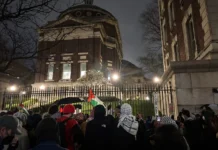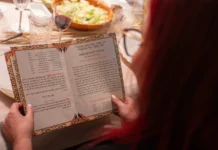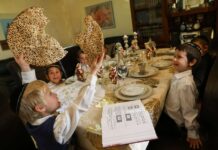Canada’s oldest Jewish community is commemorating its heritage with a newly-opened museum just outside Montreal’s historic Jewish Mile End neighborhood.
Housed in a former Jewish garment factory, the small Museum of Jewish Montreal distinguishes itself from other Jewish museums in Canada by not focusing on the Holocaust but on local Jewish history.
“One of my inspirations was looking out of the window,” says Zev Moses, the museum’s director. “I saw a building that looked like a synagogue that was converted into apartments. I googled it and there was no information about it. Eventually, I found out it was a synagogue but no one had put Montreal Jewish landmarks on a map.”
So Moses, who was 26 years old at the time and had a degree in city planning, decided to do just that.
The Museum of Jewish Montreal started out as a digital project, dots on a map representing Montreal’s old Jewish landmarks. For instance, Moses says there were at least 90 synagogues that had been converted to other uses.
Later, the museum began to offer walking tours, and finally last summer — with support from the government of Canada, the city of Montreal, and the Jewish community — established itself in a permanent physical space.
Visitors can find temporary exhibits and a cafe that serves surprising Jewish foods, such as gefilte fish sandwiches on challah bread. There is also a bookstore, with novels by Jewish authors set in Montreal, and works of nonfiction about the city’s oldest Yiddish newspaper or the smoked meat sandwiches from the famous Schwartz’s deli located just down the block. It is the only non-religious Jewish bookstore in Montreal, Moses says.
One of the recent exhibits featured old photos of Montreal synagogues next to pictures of what these buildings became: apartment blocks, churches and cultural centers. One former synagogue houses the Ukrainian National Federation of Canada; others have been reincarnated as a Greek Orthodox church, a Vietnamese Buddhist temple and a private high school called “College Francais.” The school looks like a modern building, but on closer inspection Hebrew writing can still be seen in a semi-circle above the front entrance.
“People walk by it all the time and don’t notice anything. But when we tell them to look up, they see the writing,” says Magdalene Klassen, a researcher at the museum. “This is the stuff on the tour where people are really shocked.”
The building where the museum is located is itself linked to the city’s Jewish heritage. Originally known as the Vineberg building (it was built by Abraham Vineberg in 1912), it was a garment factory that employed mostly Jewish workers. The owner thought he was a good boss because he let his Jewish workers take Saturdays off instead of Sundays, Klassen says, but the workers still hungered for higher wages.
Montreal’s Jewish history
Moses, who has lived in Montreal since he was a child, knows all about the city’s Jewish history.
Canadian Jewish history began when Montreal’s first Jews arrived in around 1760, after the British conquest. Until that time, French Catholics did not allow Jews to settle in New France, Moses says. These first Jewish settlers were English-speaking Sephardic merchants, who established Montreal’s first synagogue at the end of the 18th century.
But the largest wave of Jewish migration to Canada took place in the late 19th and early 20th centuries, when Jews began arriving from the Russian empire and Eastern Europe. Famous Montreal citizen Leonard Cohen‘s mother, for example, was a Lithuanian Jew of Russian descent, who immigrated to Canada in 1927.
Most of these new immigrants settled in the working-class Plateau neighborhood of Montreal, renting cold-water apartments along Saint-Lawrence Boulevard, also known as The Main (street), because it divides Montreal into east and west. English-speakers generally lived on the west side and French speakers on the east. Addresses in the city are counted from the Saint-Lawrence Boulevard.
“Because the city was divided between the French Catholics and the English Protestants, and the Jews lived in-between, they were able to maintain their culture and the Yiddish language much longer than other Jewish communities in North America,” Moses says. “The third most spoken language in the city for 50 years was Yiddish.”
In fact, Yiddish is still the mother tongue of about 15,000 Montreal Jews — the Hassidim, including the Belz, Satmar, Vizhnitz and Skver dynasties, as well as the Tosh (or Tash), a Hungarian dynasty entirely based in Canada with a village just north of Montreal.
However, after World War II, as the Montreal Jewish community prospered, Jews began moving away from the Plateau neighborhood to other parts of Montreal. And then, with the Quebec independence movement gaining strength, many left the French-speaking province altogether. Some settled in Toronto, which is now home to the largest Jewish community in Canada.
Jewish Montreal today
Nowadays the Jewish community of Montreal is stable, with a population of about 90,000, Moses says. French-speaking Moroccan Jews who immigrated to Montreal in the 1960s number around 25,000, and the rest are Ashkenazi, mostly English-speakers.
In recent decades, Montreal also welcomed Jews from the former Soviet Union, France and Argentina, Moses adds.
Meanwhile, the Plateau neighborhood has become one of the hippest areas to live in Montreal, with cafes and restaurants offering varied international cuisine. And while the Jewish community has moved, the neighborhood is still famous for its Jewish food — the Montreal bagels, which are baked in ovens right in front of the customers and sold when they’re still warm; the poppy seed pastries; cheese-filled blintzes; and the smoked meat sandwiches served with a pickle on the side.
Not to be outdone, the Museum’s café, Fletchers, prides itself on using the city’s rich Jewish culinary heritage to create unique dishes. For instance, they sell a cookie based on a recipe from an Iraqi Jewish Montrealer — there are said to be a few thousand Iraqi Jews living in Montreal. The cookie is made with almond flour, cardamom and rosewater and is kosher for Passover, says Kat Romanow, who is in charge of the menu.
The cafe also offers the traditional bagel with a twist — Moroccan-spiced lox.

The menu at Fletcher’s, the Jewish fusion cafe inside the Museum of Jewish Montreal. (Julie Masis/Times of Israel)
“We’re taking a very Ashkenazi dish — bagels and lox — and putting a Moroccan spice mix on the fish, marrying the two largest Jewish communities in Montreal,” Moses says.
And then there is the gefilte fish sandwich.
The gefilte fish is pan-fried and served warm with a horseradish sauce, accompanied by a carrot and parsley salad on challah. Moses says that the sandwich does not contain any of the either loved or reviled fish jelly.
“I was like, ‘No way it’s going to sell,’ but it’s probably our most popular dish,” admits Moses.






























